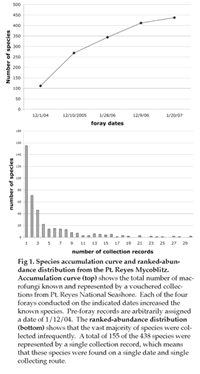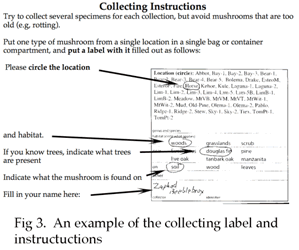point reyes mycoblitz
What we have learned from the mycoblitz

Figure 1
As of January 2014, we have records for 480 species. The majority of species were collected rarely (Fig 1). Out of the 438 species recorded from the first four forays, 308 were collected on five or fewer routes and dates. This point underlines the need for large numbers of collectors; without them we would certainly not have been able to climb the collecting curve as rapidly as we did (Fig. 1).
A species checklist is available here.
Data from the pre-existing records and the two forays show that many more species of macrofungi are likely to be found in the park. The accumulation curve for the three sets of collections shows that we have not reached a plateau; so additional species are likely to be found with additional collecting. However, most species were found in at least two or more locations or times in the park (see chart); this fact suggests that our efforts on single forays were reasonably good, at least for the fungi that people tend to collect. Also see the chart of species unique to each data set.
For some taxa, our local taxonomic expertise was certainly the limiting factor for identification. Examples include the genera Cortinarius, Russula, Inocybe, hypgeous fungi, and many genera of smaller mushrooms and all resupinate (crust-like) fungi. In the first foray, we had very limited taxonomic expertise with the small mushrooms. On the third and subsequent forays, Dr. Brian Perry, a postdoctoral associate at San Francisco State University participated and number of identified small mushrooms sky-rocketed. Mycena species, for example, jumped from 10 (combined count for the first two forays) to 20 in the third. Identification of resupinate fungi (Fig. 2) was possible only through interactions with Dr. Hal Burdsal from Wisconsin, Dr. Bob Gilbertson from Arizona, and Dr. Urmas Köljalg from Estona; all three examined specimens and provided many helpful suggestions through emails.
Sequencing

Figure 2
Sequencing of ITS (the internal transcribed spacer region of the rDNA repeat) and to a lesser extent RPB2 (RNA Polymerase B) has been crucial in several test cases. The Armillaria mellea group for example is a complex with ten North American species that are well defined by mating tests and sequence analysis1, 2, but are notorious difficult to identify morphologically because of their high level of phenotypic plasticity. Local mycologists were using morphological keys to apply a variety of names to the collections, but sequencing of the specimens from Point Reyes has so far revealed only two: A. gallica and A. mellea. This result is consistent with an earlier statewide survey of mating groups3. Inocybe species are also difficult, but with newer keys available names were applied to the collections made from Point Reyes. Using sequence of both ITS and RPB2 on a subset of these we have been able to confirm some of names, but others appear to be misapplied and several may be novel new species.
Gathering Collection Data
Giving collectors easy, but thorough, instructions on how and where to collect was crucial to obtaining good specimens and collection data. These were necessary because many people who attended the forays had little or no experience with collecting mushrooms and were drawn in primarily by the fliers for the forays. We supplied them with wax paper bags (the standard for larger mushroom collections), disposable plastic salsa containers for small specimens, signed them up for predetermined collecting routes, gave them preprinted labels with location and habitat data that could be circled, and provided a short informal demonstration of how to collect. The salsa containers were instituted on the second foray and they greatly increased the number and quality of small mushrooms obtained. We also had experienced collectors available to lead trips on many routes. In the first two forays, most of the collections were returned with no useful label data.

By the third foray we included better instructions about filling out the labels (Fig. 3), and made an effort to stress the value of them. The result was that the vast majority of specimens had useful label data in the last two forays.
Rapid presorting by mycologists was key. Figure 1 makes this point, because the 25% percent of the species that are common (and usually easy to identify) often accounted for most of the collections. After the first couple of forays we had good specimens for all of these. The strategy became to quickly sight identify these species, and save the label data but discard the specimens. The less common species were then sorted into course groups, and we examined them more closely the following day with microscopes and technical keys.
Rapid, efficient, photography for the specimens was crucial. The goals were to preserve color and size information, and to insure that images and collections stayed connected. The latter requirement was facilitated by color photo labels that were included in the images and then were stapled onto collection labels. Having someone that was both an excellent photographer and a knowledgeable mycologist was important, because it insured that key features of the specimens were documented. We were lucky to have Mike Wood as our dedicated photographer. However, in the future we would probably like to have at least two photographers present for larger forays because not all specimens can be photographed by a single person.
- Kim, M.S., N.B. Klopfenstein, J.W. Hanna, and G.I. McDonald. 2006. Characterization of North American Armillaria species: genetic relationships determined by ribosomal DNA sequences and AFLP markers. Forest Pathology, 36(3): p. 145-164.
- Piercey-Normore, M.D., K.N. Egger, and J.A. Berube. 1998. Molecular phylogeny and evolutionary divergence of North American biological species of Armillaria. Molecular Phylogenetics and Evolution, 10(1): p. 49-66.
- Jacobs, K.M., J.D. MacDonald, F.W.J. Cobb, and K. Wells. 1994. Identification of Armillaria species in California. Mycologia, 86(1): p. 113-116.
Putting It All Together

Herbarium labeling party takes a break to mug for a photo
© photo by Dr. Tom Bruns
In July 2007, the Bay Area Mycological Society organized the equivalent of a mycological barn raising to prepare the fungi for accession to the UC Berkeley Herbarium. Many participants from past mycoblitzes turned out to help. Armed with two dozen glue sticks — which were empty when we finished — we set to work. In just four hours, the group of a dozen volunteers and Dr. Bruns, matched 390 vouchered specimens into their respective boxes. This phase did not include all the fungi collected, but it was the first major addition of fungi to the UC Herbarium in many years.
All content on this page © 2008 by Tom Bruns and David Rust

 back to top
back to top